Southern Nations, Nationalities, and Peoples' Region
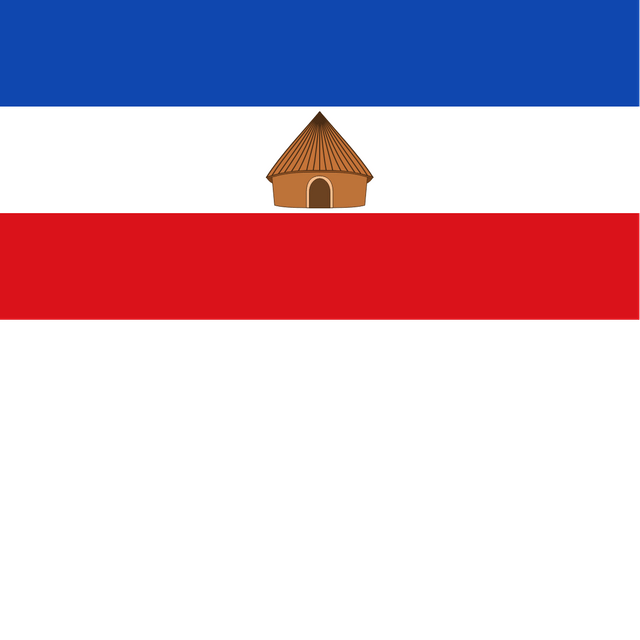
Southern Nations, Nationalities, and Peoples' Region

Southern Nations, Nationalities, and Peoples' Region ደቡብ ብሔሮች ብሔረሰቦችና ሕዝቦች ክልል | |
|---|---|
Regional State | |
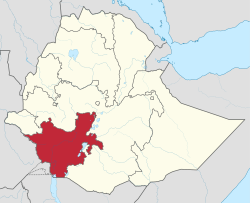 Map of Ethiopia showing Southern Nations, Nationalities, and People's Region | |
| Country | |
| Capital | Hawassa |
| Area | |
| • Total | 105,887.18 km2(40,883.27 sq mi) |
| [2] | |
| Population (2017) | |
| • Total | 19,170,007[3] |
| [4] | |
| ISO 3166 code | ET-SN |
| HDI (2017) | 0.464[5] low· 6th |
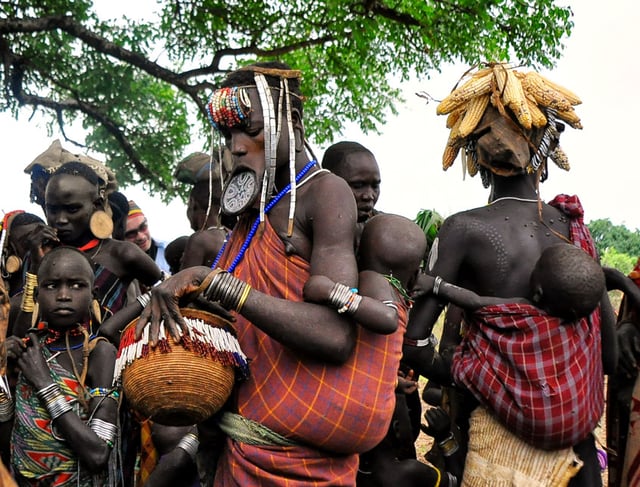
Mursi people
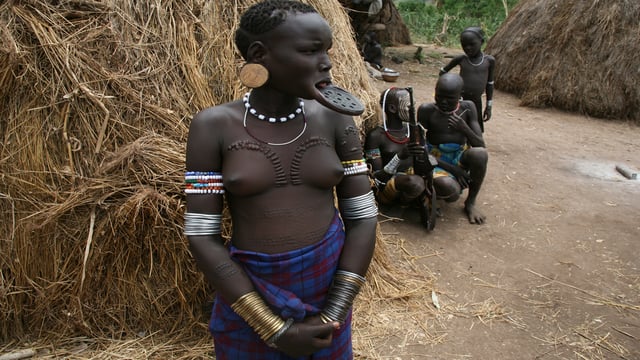
Surma people
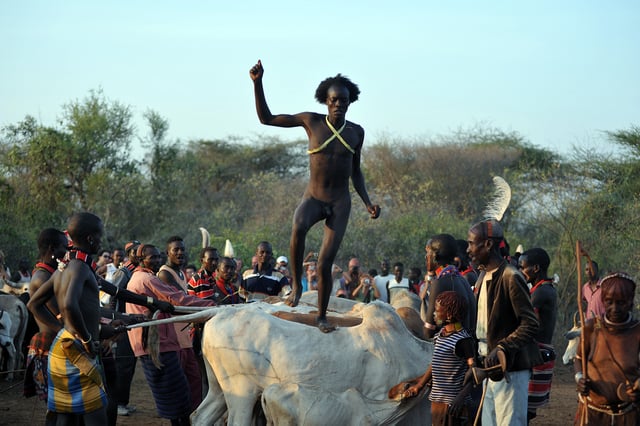
Hamar people
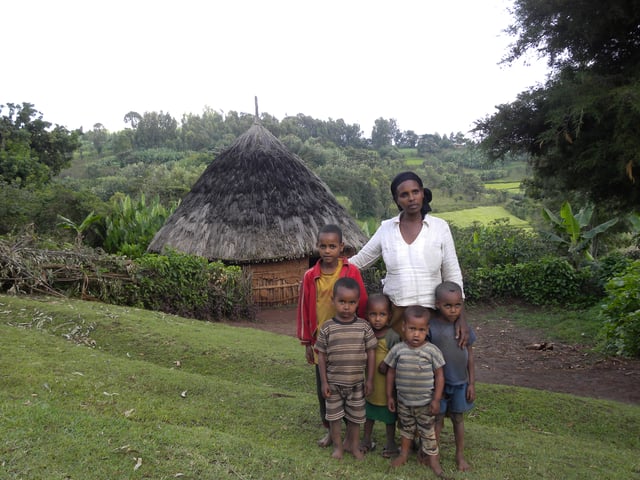
Kambaata family in front of their tukul in the Kembata Tembaro Zone
Southern Nations, Nationalities, and Peoples' Region (often abbreviated as SNNPR; Amharic: የደቡብ ብሔር ብሔረሰቦችና ህዝቦች ክልል, romanized: Yädäbub Bḥer Bḥeräsäbočna Hzboč Kllə) is one of the nine ethnically based regional states (kililoch) of Ethiopia. It was formed from the merger of five kililoch, called Regions 7 to 11, following the regional council elections on 21 June 1992.[6] Its capital is Awasa.
The SNNPR borders Kenya to the south (including a small part of Lake Turkana), the Ilemi Triangle (a region claimed by Kenya and South Sudan) to the southwest, South Sudan to the west, the Ethiopian region of Gambela to the northwest, and the Ethiopian region of Oromia to the north and east. Besides Awasa, the region's major cities and towns include Sodo, Arba Minch, Bonga, Chencha, Dila, Irgalem, Mizan Teferi, Wendo, Welkite, Durame, Hosaena and Worabe.
Southern Nations, Nationalities, and Peoples' Region ደቡብ ብሔሮች ብሔረሰቦችና ሕዝቦች ክልል | |
|---|---|
Regional State | |
 Map of Ethiopia showing Southern Nations, Nationalities, and People's Region | |
| Country | |
| Capital | Hawassa |
| Area | |
| • Total | 105,887.18 km2(40,883.27 sq mi) |
| [2] | |
| Population (2017) | |
| • Total | 19,170,007[3] |
| [4] | |
| ISO 3166 code | ET-SN |
| HDI (2017) | 0.464[5] low· 6th |
Demographics
Based on the 2007 Census conducted by the Central Statistical Agency of Ethiopia (CSA), the SNNPR has an estimated total population of 14,929,548, of whom 7,425,918 were men and 7,503,630 women. 13,433,991 or 89.98% of the population are estimated to be rural inhabitants, while 1,495,557 or 10.02% are urban; this makes the SNNPR Ethiopia's most rural region. With an estimated area of 105,887.18 square kilometers, this region has an estimated density of 141 people per square kilometer. For the entire region 3,110,995 households were counted, which results in an average for the region of 4.8 persons to a household, with urban households having on average 3.9 and rural households 4.9 people.[4] The projected population for 2017 was 19,170,007.[3]
In the previous census, conducted in 1994, the region's population was reported to be 10,377,028 of whom 5,161,787 were men and 5,215,241 were women. At the time of the census, the rural population of the Region accounted for 93.2% of the total population. Semien Omo, Sidama, and Gurage were the three zones with the highest population. The population is concentrated mostly in eastern, northern and central part of the SNNPR while the western and southern part of the region is sparsely populated.
The SNNPR Water Resources Bureau announced that as of the fiscal year ending in 2006, they had increased the area of the region that had access to drinkable water to 54% from 10–15% 15 years ago.[7] In August 2008, the head of public relations for the Bureau, Abdulkerim Nesru, announced that 94 million birr had been spent to further increase the availability of drinkable water in the region from 58% in the previous year to 63.6%. Priority was given to certain zones, such as Sidama, Welayta and Gurage, as well as the Alaba special woreda and several resettlement areas.[8]
Values for other reported common indicators of the standard of living for the SNNPR as of 2005 include the following: 10.7% of the inhabitants fall into the lowest wealth quintile; adult literacy for men is 57% and for women 22.4%; and the Regional infant mortality rate is 85 infant deaths per 1,000 live births, which is greater than the nationwide average of 77; at least half of these deaths occurred in the infants’ first month of life.[9]
| Historical population | ||
|---|---|---|
| Year | Pop. | ±% |
| 1994 | 10,377,028 | — |
| 2007 | 14,929,548 | +43.9% |
| 2017 | 19,170,007 | +28.4% |
| source:[10] | ||
Religion
| Religion | 1994 Census | 2007 Census[4] |
|---|---|---|
| Protestants | 34.8% | 55.5% |
| Orthodox Christians | 27.6% | 19.86% |
| Muslim | 16.7% | 14.12% |
| traditional religions | 15.4% | 6.6% |
| Roman Catholics | 3% | 2.4% |
| other religious affiliations | — | 1.5% |
Ethnicities
The SNNPR, being an amalgam of the main homelands of numerous ethnicities, contains over 45 indigenous ethnic groups.
| People | 1994 Census | 2007 Census[4] |
|---|---|---|
| Sidama | 18% | 19.38% |
| Welayta | 12% | 10.59% |
| Hadiya | 7.98% | |
| Gurage | 15% | 7.54% |
| Gamo | 7% | |
| Kafficho | 5.44% | |
| Silt'e | 5.37% | |
| Amhara | 4.10% |
- All ethnicities
The ethnicities native to the SNNPR, with percentages of the population as reported in the 2007 national census and organized by linguistic grouping, include:[4]
Cushitic: Alaba – 1.35%, mostly in Alaba special woreda Arbore – 0.04% Daasanach – 0.32%, mostly in Dasenech (woreda) Dirashe – 0.2%, mostly in Dirashe special woreda Gawwada – 0.43%, mostly in Dirashe special woreda Gedeo – 4.9%, mostly in Gedeo Zone Hadiya – 7.98%, mostly in Hadiya Zone Kambaata – 3.82%, mostly in Kembata Tembaro Zone Konso – 1.47%, mostly in Konso special woreda Libido (or Mareqo) – 0.38%, mostly in Mareko (woreda) Sidama – 19.38%, mostly in Sidama Zone Tsamai – 0.13%, mostly in Bena Tsemay (woreda)
Nilo-Saharan: Bodi – 0.04% Kichepo Kwegu – 0.01% Me'en – 1% Mursi – 0.05%, mostly in South Omo Zone Nyangatom – 0.12%, mostly in Nyangatom (woreda) Shabo, mostly in Keficho Shekicho Zone Shita people Suri/Surma – 0.17%, mostly in Surma (woreda)
Omotic: Aari – 1.9%, mostly in Bako Gazer (woreda) Basketo – 0.52%, mostly in Basketo special woreda Bench – 2.34%, mostly in Bench Maji Zone Burji – 0.38%, mostly in Burji special woreda Chara – 0.08%, mostly in South Omo Zone Dawro – 3.28%, mostly in Dawro Zone Dime – < 0.01% Dizi – 0.23%, mostly in Maji (woreda) Dorze, mostly in Chencha (woreda) Gamo – 7%, mostly in Gamo Gofa Zone Goffa – 2.41%, mostly in Gamo Gofa Zone Hamar – 0.31%, mostly in Hamer (woreda) Kachama, mostly in Arba Minch (woreda) Karo – 0.01% Kafficho – 5.44%, mostly in Keffa Zone Konta – 0.54%, mostly in Konta special woreda Koorete – 1.02%, mostly in Amaro special woreda Male – 0.59%, mostly in Male (woreda) Mello, mostly in Melokoza (woreda) Oyda – 0.25%, mostly in Oyda (woreda) Shakacho – 0.44%, mostly in Sheka Zone Sheko – 0.24%, mostly in Sheko (woreda) Welayta – 10.59%, mostly in Wolayita Zone Yem (Yemse) – 0.5%, mostly in Yem special woreda
Semitic: Amhara – 4.10%, widespread Gurage – 7.54%, mostly in Gurage Zone Silte – 5.37%, mostly in Silt'e Zone Zayse – 0.1%, mostly in the Lake Zway area Zergula
Languages
The 2007 census reported that the predominantly spoken mother tongue languages include Sidama (19.59%), Welayta (10.48%), Hadiya (8%), Gurage languages (7.13%), Gamo (6.9%), Kafa (5.36%) and Amharic (4.10%). Other languages spoken in the State include Kambaata, Mello, Goffa, Gedeo and Dima; because of the relatively few number of speakers of most of the languages in the region, the working language of the state is Amharic (the most widely spoken language in Ethiopia and formerly the only official language).[4]
The 1994 census reported that the predominantly spoken languages include Sidamigna (18%), Guragigna (14.72%), Welayta (11.53%), Hadiyigna (8.53%), Keffigna (5.22%), and Kembatigna (4.35%). Other languages spoken in the State include Gamoigna, Mello, Goffa, and Gedeo.[11]
Amharic is still the working language although most pupils get eight years of primary education in their home language and all secondary and further education is in English.[12]
Agriculture
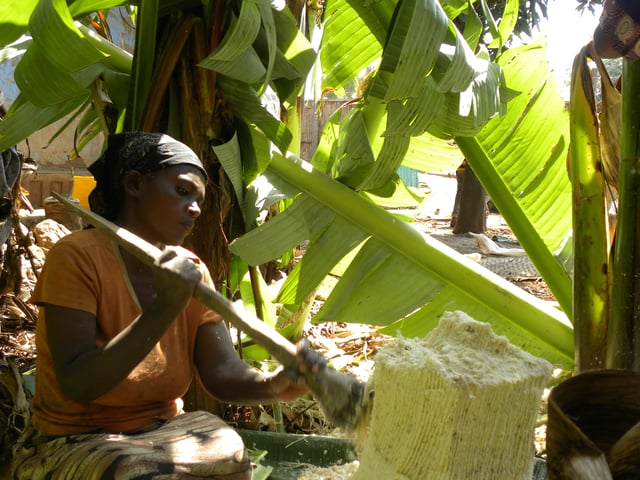
A Kambaata woman extracting the edible part of an enset (a major staple crop of the SNNPR) with a traditional tool.
The CSA reported that for 2004–2005 100,338 tons of coffee were produced in the SNNPR, based on inspection records from the Ethiopian Coffee and Tea authority. This represents 44.2% of the total production in Ethiopia.
Farmers in the Region had an estimated total 7,938,490 head of cattle (representing 20.5% of Ethiopia's total cattle), 3,270,200 sheep (18.8%), 2,289,970 goats (17.6%), 298,720 horses (19.7%), 63,460 mules (43.1%), 278,440 asses (11.1%), 6,586,140 poultry of all species (21.3%), and 726,960 beehives (16.7%).[13]
Enset is a major indigenous local crop in the SNNPR.
Presidents of the Executive Committee
Administrative zones
The following list of administrative zones and special woredas (an administrative subdivision which is similar to an autonomous area and is not part of a zone) is based on information from the 2007 census; the list of second administrative level bodies maintained by the United Nations Geographic Information Working Group dates from 2002, and shows a previous subdivision.[16]
Bench Maji
Dawro (formerly part of North Omo Zone)
Gamo Gofa (formerly part of North Omo Zone)
Gedeo
Gurage
Hadiya
Keffa (formerly part of Keficho Shekicho Zone)
Keficho Shekicho
Kembata Tembaro
North Omo[1]
Sheka (formerly part of Keficho Shekicho Zone)
Sidama
Silti
South Omo
Wolayita (formerly part of North Omo Zone)
Alaba (special woreda)
Amaro (special woreda)
Basketo (special woreda, formerly part of North Omo Zone)
Burji (special woreda)
Dirashe (special woreda)
Konso (special woreda)
Konta (special woreda, formerly part of North Omo Zone)
Yem (special woreda)
Note
See also
List of districts in the Southern Nations, Nationalities, and Peoples' Region